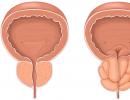Polyp in the uterus and pregnancy
There are among benign uterine formations and polyps, which are formed from the inner mucous of the uterine layer.
Such neoplasms are found in about 10% of women, and among gynecological problems, polyps occupy about a quarter of cases. Such a statistical picture indicates a considerable prevalence of such a disease.
In fact, polyps are a kind of intrauterine outgrowths protruding into the uterine cavity. These are pathological mucous growths that have a stalk or grow on a wide base.
They differ in structure, location, size, histological structure, and can develop completely asymptomatically. Although most often uterine polyps are manifested by painful symptoms, bleeding and infertility.
Causes of endometrial polyposis
The main cause of the formation of uterine polyps are neurohormonal factors and inflammatory endometrial changes.
- They provoke the occurrence of polyps of a condition like hyperestrogenism or hormonal ovarian dysfunction. These conditions are accompanied by hyperplastic endometrial changes in the form of polypoid growths. Such conditions are often accompanied by pathologies characteristic of elevated estrogen levels, such as uterine fibroids, mastopathy or glandular endometrial hyperplasia, adenomyosis, or ovarian polycystosis.
- Contribute to endometrial polyposis chronic pathological processes: female inflammations such as oophoritis, adnexitis or endometritis, genital infections, damage to the uterus during abortion and curettage, long-term wearing of an intrauterine device.
- At risk the appearance of endometrial polyps, specialists include women with obesity, neuropsychiatric disorders, immune failures, thyroid pathologies, hypertension or diabetes.
- Vascular growths can also cause the development of polyposis. With blockage or growth of the vascular channels around them, active reproduction of epithelial cells begins.
- It happens that polyposis in the uterine cavity is caused by a genetic predisposition, a hypodynamic lifestyle, or long-term use of Tamoxifen. This medication is used in antitumor therapy to block hormone-sensitive receptors. As a result, in some patients, polyposis formations begin to actively grow.
Types of uterine polyps
Polyps have a fairly simple structure, including a leg and a body.
The body is the polyp, and the leg performs the function of attachment, that is, it attaches the formation to the uterine wall. In accordance with the location, specialists distinguish polyps of the uterine body and.
Photo of a polyp on a leg in the uterus
According to histological features, uterine polyps are divided into the following varieties:
- Fibrous- such formations are formed from connective tissue cells, have a dense structure, occur mainly in women after 40 in the premenopausal or menopausal period, when massive hormonal changes occur in the female body;
- glandular- consist of glandular cellular structures. Such polyps usually occur in relatively young patients. They can develop in the form of cystic formations that have fluid inside. The most common cause of such a polyposis is endometrial hyperplasia;
- Adenomatous- in their composition there are atypical altered cellular structures. Such formations are prone to malignancy;
- Glandular fibrous- consist of a mixture of connective tissue and glandular cellular structures;
- Placental- such polyposis formations are formed in women after childbirth if placental cells remain in the uterine cavity, from which polyps then develop.
Symptoms and signs
Polyps of the uterus can sometimes develop in a latent way, that is, covertly, but still, over time, the pathology acquires a characteristic set of symptoms, which are as follows:
- When the latent stage of development ends, the patient begins to worry about bleeding from the uterus of a dysfunctional nature of an acyclic or cyclic type. Menstruation becomes profuse and painful, and before them brownish vaginal discharge disturbs;
- Any sexual contacts cause discomfort and pain, and after them, spotting is also disturbing;
- Patients of menopausal age develop unusual bleeding;
- Frequent blood loss provokes the development of iron deficiency, which sometimes manifests itself in very severe anemic forms. The patient often experiences weakness, dizziness, her skin acquires pale shades;
- If multiple or single polyps reach large sizes, then the patient is disturbed by pain localized just above the pubic region. Painful symptoms can be constant and aching in nature, and in some patients the pain is cramp-like and occurs periodically;
- Often, endometrial polyposis in women is accompanied by the release of vaginal mucous whites;
- Polyps can cause miscarriages and infertility, so with such problems, it is imperative to undergo the necessary examination for polyposis.
Similar symptoms are characterized by uterine pathologies like endometriosis, malignancy. Therefore, polyps need mandatory medical supervision.
Polyp in the uterus and pregnancy
Polyposis formations can provoke infertility or miscarriage, so they are very dangerous for pregnancy. The ideal option is to remove polyps before pregnancy.
Experts consider such a combination not very pleasant, but not tragic either. If a woman was able to become pregnant in the presence of polyposis, then usually the pregnancy proceeds without any complications in the future.
Of course, there are risks of abortion, but it all depends on the specific situation. In any case, after the birth of the baby, the polyps are removed.
Sometimes polyposis formations form in the uterine body after childbirth. Usually, placental polyps appear at the site of placental remnants. In a similar situation after childbirth, a woman is worried about heavy uterine bleeding for about three weeks.
Placental polyps are surgically removed along with the remnants of the placenta, then curettage is performed.
Size of outgrowth and how fast can it grow?
Polyps of the body of the uterus can have different sizes from 1 to 30 mm, although most often such formations do not exceed 10 mm.
A polyp may not grow for a long time and not cause trouble for the patient, but in the presence of provoking factors such as progesterone deficiency, pregnancy, abortion, curettage, the growth of polyposis formations may increase.
Diagnostics
After a medical examination, the patient is sent for diagnostic procedures:
- Ultrasound procedure;
- Hysteroscopic diagnosis;
- Scraping;
- Metrography is an x-ray examination of the uterine cavity.
Photo of ultrasound diagnosis of a polyp in the uterus

If necessary, the diagnosis of uterine polyps is supplemented by other studies.
Education treatment
The main way to get rid of uterine polyps is considered.
Polypectomy is performed during hysteroscopy. Usually the procedure is carried out 2-3 days after menstruation. Such terms are explained by the fact that during this period the endometrial layer is thin and polyposis formations are perfectly visible. Removal is carried out with an electric loop, and the place of separation is cauterized.
If the formations are small, then the doctor may recommend. Preparations containing hormones can reduce the production of estrogen, and the level of progesterone, on the contrary, increases.
As a result, the hormonal causes of polyposis are eliminated, the formations shrink and leave the uterus during the next menstruation.
If polyposis is due to endometrial inflammation, then antibiotic therapy is indicated.
With the multiple nature of polyposis, therapy can be supplemented with endometrial curettage in those areas where there are accumulations of polyps. After scraping, the damaged areas are disinfected with a special solution. Removed polyps are sent for histology.






